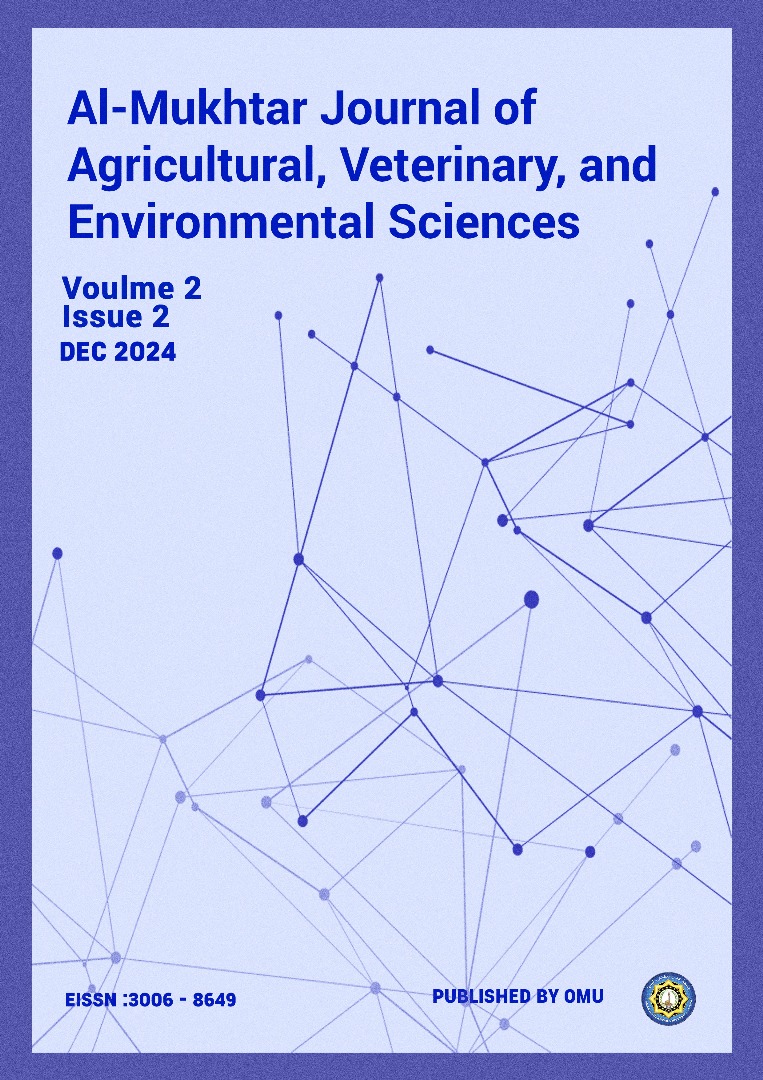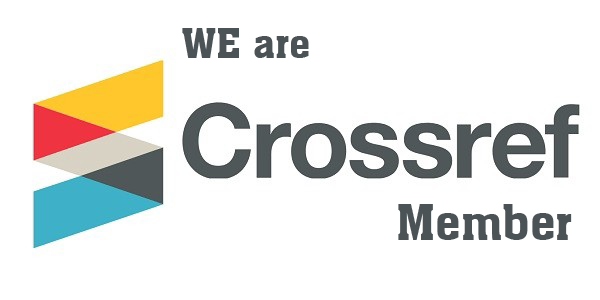Impact of Soaking Wheat Grains in Gibberellic Acid Under Varying Sodium Chloride (NaCl) Concentrations
DOI:
https://doi.org/10.54172/v66q4w65Keywords:
wheat, seeding growth, gibberellic acid, conditions of salt stressAbstract
an experiment was conducted in the laboratory of the Department of Crop Science, Faculty of Agriculture, Omar Al-Mukhtar University, during the 2022-2023 season to study the effect of gibberellic acid GA3 on the germination and growth characteristics of wheat seedlings (Salambo) under salt stress. The experiment was conducted using a completely randomized design (C.R.D) in three replications, the treatments were (soaking wheat grains in gibberellic acid, no soaking) and concentrations of sodium chloride salt (NaCl) (distilled water compared to control, 4000ppm, 6000 ppm, and 8000 ppm). The results indicated that the treatment of soaking grains in gibberellic acid was significantly superior to the treatment without soaking in all the studied traits represented by "germination percentage %, seedling length (cm), root length and shoot length "cm", seedling wet and dry weight "g" and Seedling vigour index ". The results showed highly significant differences between sodium chloride salt concentrations compared to the (Control) treatment, where the germination percentage %, seedling length "cm", shoot and root length "cm", seedling wet and dry weight (g), and Seedling vigor index decreased with increasing salt concentration up to (8000 ppm). The results showed no significant differences in the interaction between soaking treatments and sodium chloride salt concentrations in all studied traits except for germination percentage, where the treatment of soaking grains in gibberellic acid with distilled water (control) recorded the highest values compared to the lowest values recorded when grains were not treated with sodium chloride concentration (8000 ppm).
References
Akbarimoghaddam, H., Galavi, M., Ghanbari, A & Panjehkeh, N. (2011). Salinity effects on seed germination and seedling growth of bread wheat cultivars. Trakia J. Sci. 9 (1), 43–50.
Anaya, F., Fghire, R., Issa Ali, O., Wahbi, S & Loutfi, K. (2013). Effet du stress salin sur la ger-mination de fe`ve (Vicia faba, L.). 5e`me Rencontre Nationale Gestion et Protection de l’Environnement G-ENVIRO5. 28-05-2013 Casablanca Maroc.
Arafa,A.A., M . A. Khafagy & M. F. El-Benna. (2009). The effect of glycine betaine or ascorbic acid on grain germination and leaf structure of sorghum plant grown under salinity stress, J.Crop Sci.3(5):294-304.
Attiya, H. J & K.A.Jaddoa.(2011).Plant Growth Regulator, The Theory and Practice. Ministry of Higher Education and Scientific Research.Publication Republic of Iraq.
Carvalho, R.F., Piotto, F.A., Schmidt, D., Peters, L.P., Monteiro, C.C& Azevedo, R.A. (2011). Seed priming with hormones does not alleviate induced oxidative stress in maize seed-lings subjected to salt stress. Sci. Agric. 68,598-602.
Collins, E. (1993). Why Wheat? Choice of Food Grains in Europe in the Nineteenth and Twentieth Centuries, Journal of European Economic History; Rome Vol. 22, Iss. 1, https://Search.Proquest.com.
FAO, (2010). bandue de donnees statistiaue: www.fao.org.
Gomez, K.A. &A.A. Gomez. (1984). Statistical Procedures for Agricultural Research. 2nd Edn., John Wiley Sons, New York, USA., ISBN: 978-0-471-87092-0, Pages: 704.
Hermann, K., Meinhard, J., Dobrev, P., Linkies, A., Pesek, B., Heß, B& Leubner-Metzger, G. (2007). 1-Aminocyclopropane-1-carboxylic acid and abscisic acid during the germination of sugar beet (Beta vulgaris L.): a comparative study of fruits and seeds. J. Exp. Bot.58(11),3047–3060.
ISTA"International Seed Testing Association”. (2005). International Rules for Seed Testing. Adopted at the Ordinary Meeting., Budapest, Hungary to become effective on 1st January 2005.The International Seed Testing Association.
Leyl,I., Z . Dumlupinar., S. N. Kara.,C . yurudurmaz & M. Colkesen. (2012). The effect of differ-ent temperature and salt concentrations on some popcorn lium. AJCS,5(8):973-978.
Memon, S.A., Hou, X& Wang, L.J. (2010). Morphological analysis of salt stress response of Pak Choi. ejeafche 9 (1): 248–254.
Othman, Y, G, AL-Karaki, A, R, Tawaha and A, AL- Horani. (2006). variation germination and ion uptake in genotype barley under salinity condition world J, Agric, sci 2, 11-15.
Piwowarczyki. B., W. Kaminska &W. Rybinski. (2014). In fluence of PEG Generated osmotic stress on shoot regeneration and some Biochemical parameters in Lathyrus culture, Czech J. Genet. Plant Breeding, 50 (2). 77-83.
Qu, X.X., Huang, Z.Y. (2005). The adaptive strategies of halophyte seed germination. Acta Ecol. Sin. 25 (9), 2389–2398.
Shinozaki, K., Uemura, M., Bailey-Serres, J., Bray, E. A. & Weretilnyk, E. (2015) In Biochemistry and Molecular Biology of Plants (eds Buchanan, B. B., Gruissem, W. & Jones, R. L.) Ch. 22, 1051–1100 (Wiley, Chichester).
Downloads
Published
License
Copyright (c) 2024 Ahmed S. Issa Buhedma, Imbarkah F Aboubakr, Ayiman F Ahmed , Gamila S. Muhammed (Author)

This work is licensed under a Creative Commons Attribution-NonCommercial 4.0 International License.













